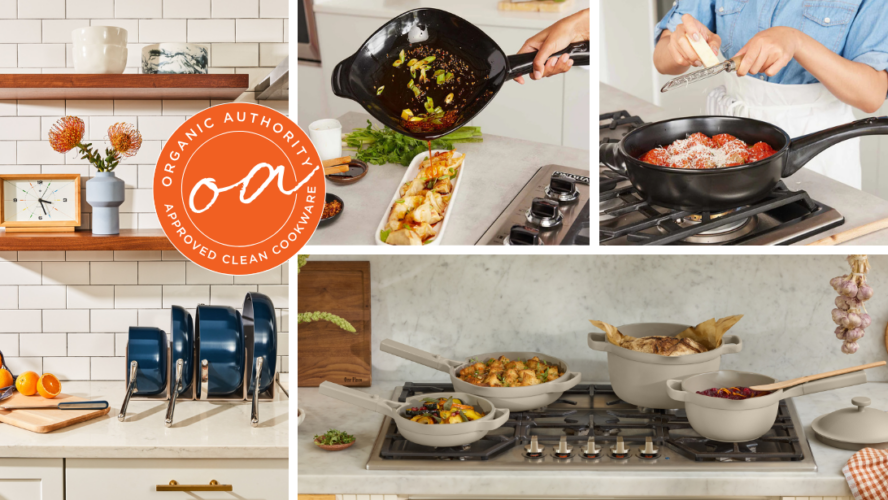
As consumers seek non-toxic alternatives to traditional nonstick pans, ceramic cookware has become increasingly popular. But even after you’ve decided you want to invest in non-toxic nonstick, it’s still easy to be overwhelmed by the wide range of options and ceramic cookware pros and cons — from the centuries-old technology used to craft 100% pure ceramic pans to the metal-core pans with alternative ceramic coatings.
Depending on the ceramic cookware you choose, you may find the practical performance, environmental impact, and even potential health implications vary widely. Luckily, we’re here to help. This guide explores and compares these factors for various ceramic cookware options to help you make informed decisions for your kitchen needs.
TL;DR: What Do You Need to Know About Ceramic Cookware?
- Conventional nonstick cookware is made with PFAS chemicals (also known as “forever chemicals”) like PTFE and PFOA, which can leach harmful additives to your food
- Ceramic cookware offers a non-toxic alternative to traditional nonstick, and is sold in two distinct categories: 100% pure ceramic or ceramic-coated nonstick cookware
- Ceramic-coated nonstick is the most common alternative to traditional nonstick, and it offers excellent non-toxic, nonstick performance out of the box — but durability isn’t its strongest suit
- To ensure your ceramic nonstick lasts as long as possible, take extra precautions: use silicone or wood utensils and avoid stacking them
- Overall, these pans are great for gentle cooking and delicate foods, and are best used as part of a mixed cookware set
What Are the Pros and Cons of Ceramic Cookware?
For the purposes of clarity in this guide, the term “ceramic cookware” will refer to ceramic-coated cookware. When we mean pure ceramic, we will specify!
As with any choice you make in the kitchen, there are pros and cons to choosing non-toxic ceramic-coated cookware. Here are the important things to know at a glance.
| Pros | Cons |
| 1. Non-toxic: No PTFE, PFOA, or “forever chemicals” | 1. Coating wears off in 1-3 years |
| 2. Great nonstick performance when new — ideal for eggs, crepes, pancakes | 2. Scratches easily (must avoid metal tools and stacking) |
| 3. Heats evenly with no hot spots | 3. Not good for high-heat cooking like searing or stir-frying |
| 4. Stylish look for modern kitchens | 4. Can’t go from hot stove to cold sink due to risk of cracking |
| 5. Easy to clean when new | 5. Not easily recyclable |
| 6. Doesn’t affect food taste (non-reactive surface) | 6. Loses nonstick performance over time |
| 7. Better heat retention than aluminum or steel | 7. More expensive and less durable than traditional nonstick |
| 8. Lightweight and easy to handle |
The Science Behind Ceramic Cookware
Before we dive straight into the science, let’s remind ourselves of one of the key problems the cookware industry is facing: toxic nonstick cookware. Home chefs have long loved traditional nonstick cookware for its easy, breezy, slide-right-off-the-pan qualities. Unfortunately, as we’ve covered extensively in articles that discuss why PTFE nonstick is not safe, these conventional pans are releasing synthetic PFAS chemicals like PTFE (Teflon) and GenX into the food we cook.

These toxic additives aren’t safe for our bodies or our planet. And once they’re released, they tend to stick around — they’ve been dubbed ‘forever chemicals’ for a reason. In the U.S., unregulated dumping of these chemicals has led to their presence in an alarming 610 drinking water sources in 43 states1. The long-term health effects of contact with PFAS chemicals include immune, kidney, and reproductive repercussions, not to mention an increased risk of cancer2.
That’s where ceramic cookware comes in. Ceramic nonstick pans look quite a bit like traditional nonstick pans, but they’re wholly devoid of these nasty chemicals. So has modern science unlocked a solution to the issues of traditional nonstick? Let’s dig in.
How Is Ceramic Cookware Made?
Contemporary ceramic cookware begins with a metal core made from stainless steel, aluminum, or a mix of both. This base pan is then coated for a nonstick finish. Most ceramic-coated cookware uses a sol-gel technology, which involves a chemical process that converts inorganic liquid substances into a solid ceramic-like coating.
The resulting glossy coating degrades more quickly than traditional nonstick, but there’s no risk of the dangerous off-gassing that can occur with traditional nonstick pans at high temperatures. If you ask us, we think that’s a fair price to pay for our health.
What Modern Ceramic Coatings Actually Contain
Notice how we said the sol-gel technology creates a “ceramic-like” coating? Well, that’s because modern ceramic cookware typically doesn’t rely on traditional ceramic, but rather on nanoparticle-based coatings made from silicon dioxide — essentially refined sand — combined with other minerals like titanium dioxide or aluminum oxide for added strength.
These natural minerals give the surfaces of these pans their smooth feel and nonstick characteristics, and they’re entirely devoid of the toxic PFAS forever chemicals used to produce traditional nonstick pans. Plus, the resulting coating is non-reactive, meaning it won’t change the flavor of your food or react with acidic ingredients like tomatoes (unlike pure metal pans, which can!).
Pure Ceramic vs. Ceramic-Coated Options
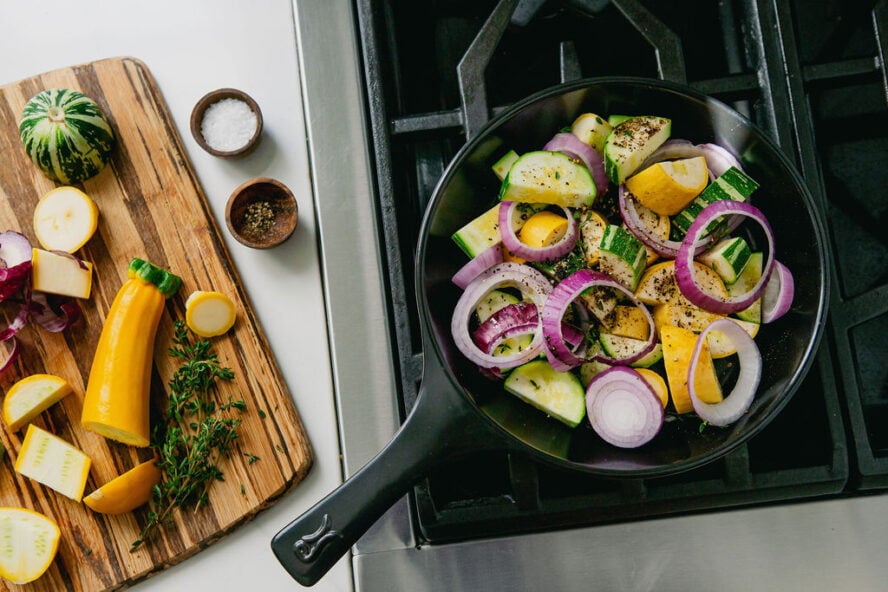
For those who want to keep it all natural, you can opt for pure ceramic cookware — but know that it offers different pros and cons than ceramic-coated options. Pure ceramic cookware is typically made from clay, minerals, and water fired at high temperatures (2000°F+) to create a glossy, non-porous surface. This means it doesn’t need to be coated, and as a result, it has a far longer lifespan than coated alternatives.
Of course, there are some downsides to choosing pure ceramic. The surface of these pans isn’t quite as nonstick as that of coated pans. While there’s no real risk of scratching or flaking, these pans tend to be more brittle and vulnerable to thermal shock than other kitchen workhorses like stainless steel, carbon steel, or cast iron. You’ll want to avoid heating a 100% ceramic pan over a ripping hot flame or deglazing it with cold liquids once hot.
While pure ceramic is definitely more expensive upfront (with prices three to five times that of ceramic-coated pans), these pans are built to last. This makes them a more environmentally-friendly option and a better investment in the long run.
Ceramic Cookware That Features More Pros than Cons
While there are advantages and disadvantages to opting for ceramic-coated nonstick cookware, we believe the right brand offers more pros than cons. To fill you in, we’ve tested all of the top ceramic cookware brands so that you don’t have to. Here are the pans we believe have earned a well-deserved place in your kitchen.
Xtrema Cookware
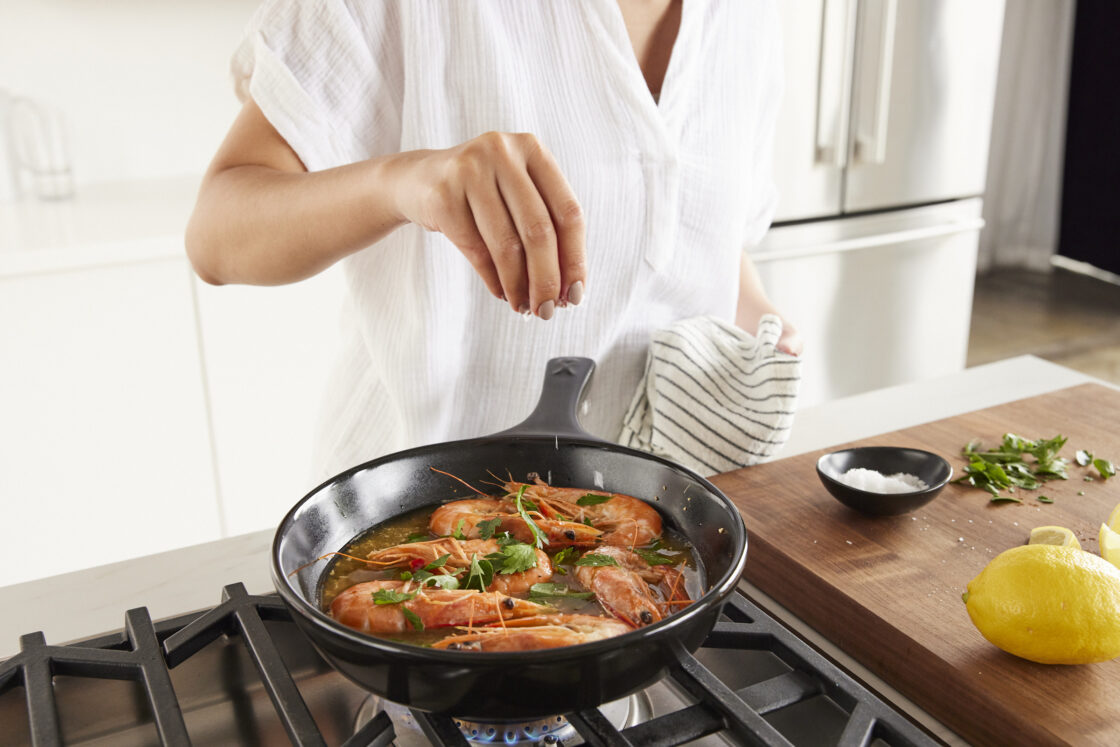
Xtrema is one of the few brands that offers 100% pure ceramic construction: no metal core and no synthetic coatings. The result is a durable, non-toxic nonstick alternative perfect for health-conscious and eco-minded cooks. If safety, durability, and longevity are essential values for you, Xtrema could be a perfect fit.
Xtrema pans are great to cook with, particularly for experienced cooks (our Editor-in-Chief and trained chef Laura Klein covers how much she loves using their pure ceramic here). Their ceramic build means they boast great heat retention and distribution. It also means they offer more heft than nonstick, but they’re still 40% lighter than cast iron — a real Goldilocks “just right” situation.
They’re immune to flaking and scratching, but they do require a bit of TLC. To show off their nonstick capabilities, they’ll need to be preheated and greased. But keep in mind that even with the proper care, their surfaces will never be quite as slick as coated nonstick. Instead, the trade-off you get for slightly lower nonstick performance is cookware that truly stands the test of time.
Pros that Stand Out
There are a lot of benefits of 100% ceramic cookware, but perhaps the most critical is an absence of the health risks associated with traditional nonstick pots and pans. Cookware like Xtrema begins and ends with ceramic, so there’s no risk of flaking, heavy metal contamination, or exposure to toxic forever chemicals.
This construction also makes this cookware extremely versatile — it can be used in the oven, on the stovetop, and even in the microwave. And unlike many ceramic-coated nonstick pans, pure ceramic pieces are dishwasher-safe. Their lack of coating makes these pans safe to use at high temperatures, and their excellent heat retention makes them perfect for recipes that require a slow, even cook (we especially love Xtrema’s Dutch oven for this).
The bottom line? Xtrema cookware is the safest we’ve found. Moreover, it’s built to last, making it a great long-term investment in toxin-free cooking.
Our Place Cookware
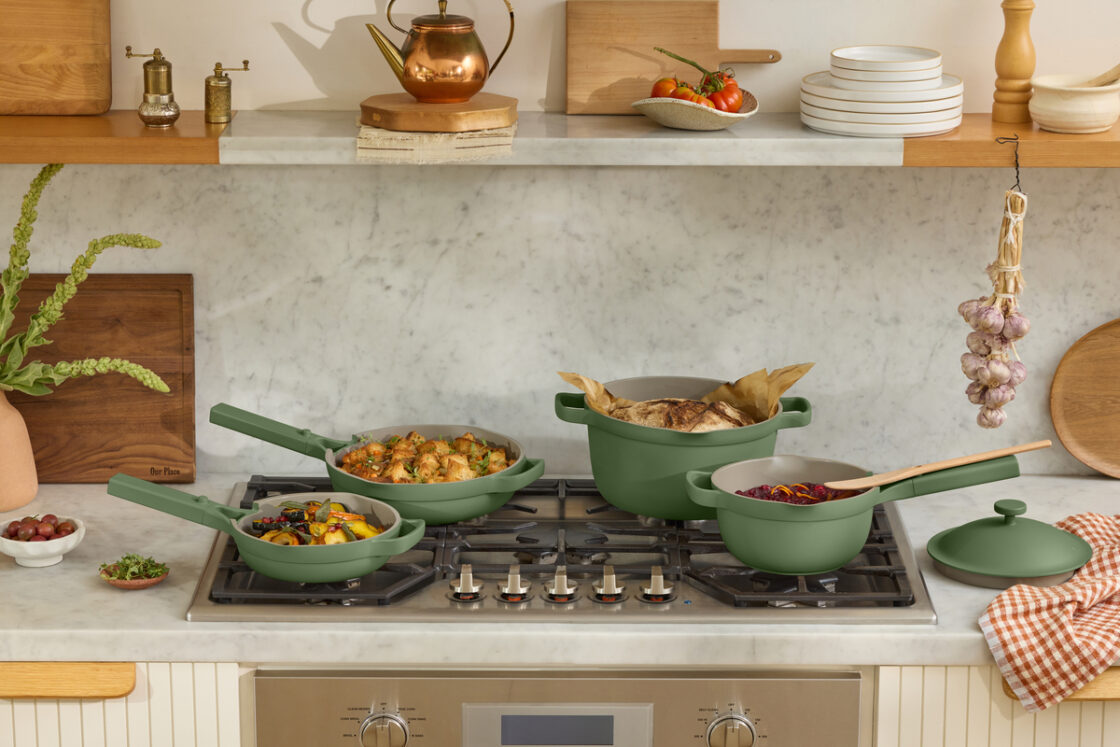
For the minimalist looking for a non-toxic nonstick cookware option, Our Place offers the perfect, multi-functional pans in a range of gorgeous pastel hues, from periwinkle to mossy green and Millennial pink.
Pros That Stand Out
Our Place cookware earns high marks for its sleek, elegant design. Their pans come with eye-catching, bulbous lids and a variety of handle accents (choose between monochrome color matching or bright gold and silver).
These pans also stand out for their versatility. The Always Pan and Perfect Pot are great multi-use pieces — each piece can stand in for a steamer, skillet, and saucepan. This makes them a great choice for apartment dwellers with limited storage space or chefs who just want to do more with less. And their versatility doesn’t stop there — they also work with all cooktops, including induction.
A lightweight aluminum core makes these pans perfect for beginner home cooks. And like all ceramic coated nonstick, while the coating does have a tendency to degrade over time, you can get a good amount of use from them by treating these pans with care (and keeping them out of the dishwasher).
Caraway
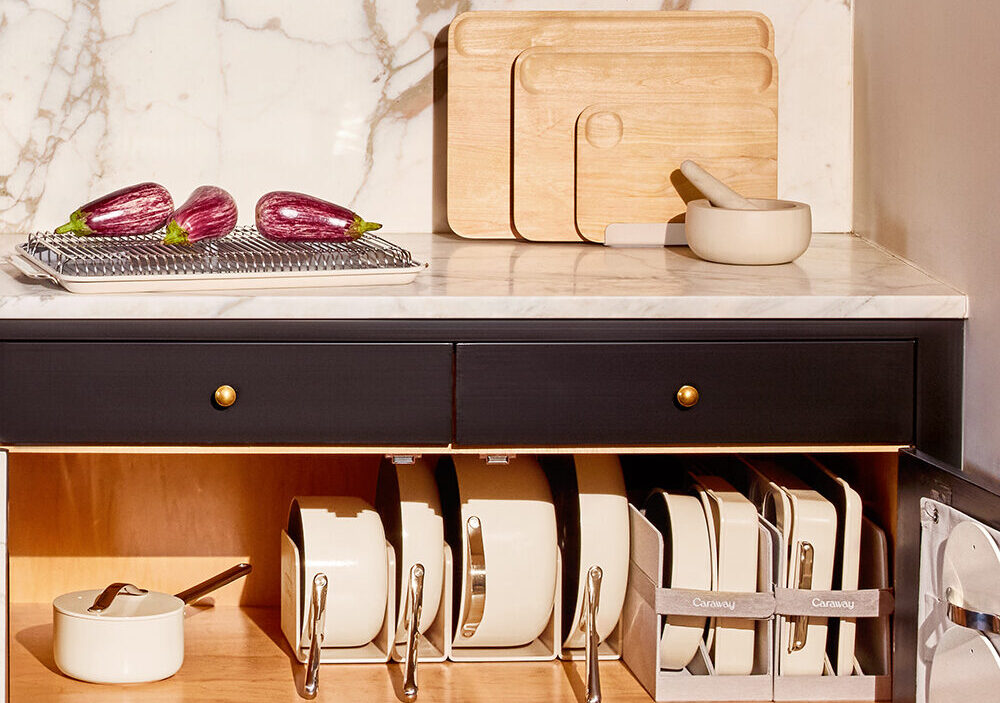
For gorgeous non-toxic cookware that performs nearly as well as traditional nonstick, turn your attention to Caraway. Like many non-toxic nonstick options, this cookware line begins with an aluminum core. This gets coated with a ceramic coating, which is devoid of toxins like PTFE, GenX, and heavy metals like lead and cadmium.
While the non-toxic ceramic coating of most similar pans tends to sacrifice performance, Caraway shines in the kitchen. In our testing, its nonstick layer held up remarkably well over time — even at oven temperatures of up to 550ºF. These pans are ideal for quick meals and easy cleanup.
Pros That Stand Out
Caraway cookware marries beauty and performance (read our review of caraway cookware after 5 years of testing!) for a line of non-toxic, nonstick cookware that’s stylish enough to be displayed as a point of pride on your stovetop. Or if you prefer a more streamlined look in your kitchen, we also love Caraway’s built-in organization system that helps keep your pans’ surfaces from coming into contact with one another, ultimately increasing their lifespan. (And if you love their approach to organization, you’ll love their food storage products, too.)
And Caraway is way more than just a pretty face. This cookware offers truly nonstick surfaces that last way longer than many competitors’ (and if you’re more of a baker, their bakeware is just as good). The company’s eco-friendly packaging and sustainable sourcing seal the deal on this winning option.
Why People Love Ceramic Cookware
Once you go ceramic, it’s hard to go back. Here are some of the many reasons we (and countless others) love ceramic nonstick.
Healthier Cooking Without Harsh Chemicals
It’s true, we can’t shut up about this one — but it bears repeating. One of the biggest reasons that people switch to ceramic cookware is to get chemicals out of their kitchens.
Traditional nonstick can release harmful fumes at high temperatures, pollutes our waterways, and causes a variety of health issues. Ceramic coatings are free from these compounds and are considered a much safer option for home cooks looking to reduce their exposure to dangerous chemicals.
Easy to Clean and Use (Especially When New)
Fresh out of the box, ceramic nonstick works just as well as traditional, with a glossy, nonstick surface that’s perfect for scrambling eggs or flipping pancakes with ease — and without much added fat. And given its slick surface, this cookware is a breeze to clean: all you need is a soft sponge and warm water.
Over time, however, the nonstick performance does fade — usually within 50 to 100 uses. But if you use these pans sparingly and treat them with care, they’ll serve you well.
Even, Gentle Heating for Delicate Dishes
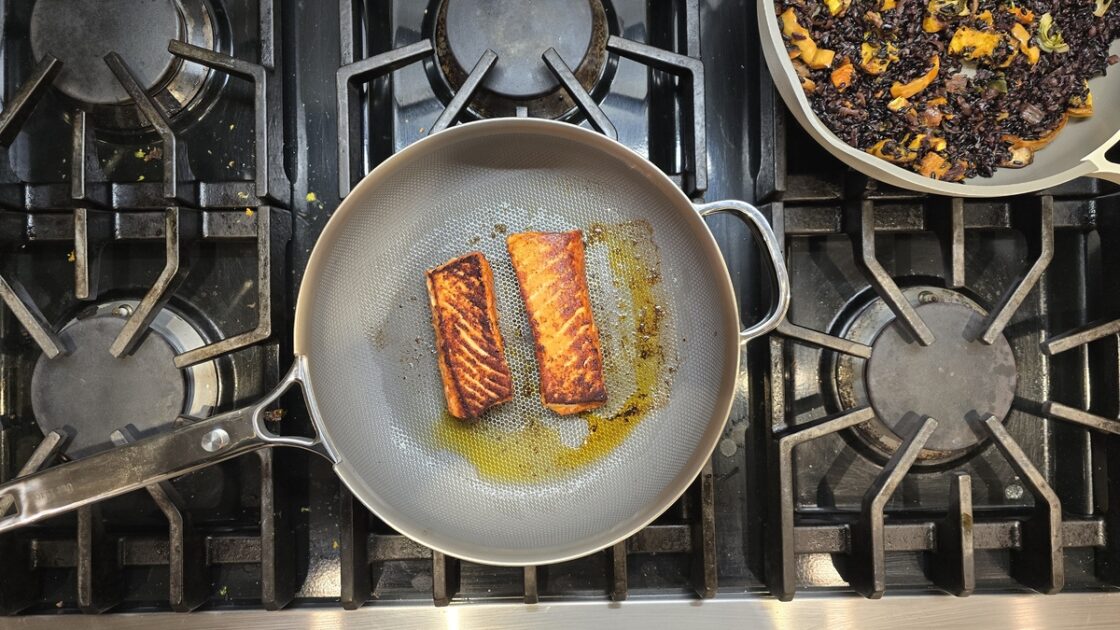
To cook delicate ingredients like eggs and fish to perfection, ceramic cookware is your girl. These pans don’t do well over roaring hot heat, but their slow-burn vibe — and lack of hot spots — make them perfect for controlled cooking of dishes like lean fish, emulsified sauces, and custards, where precision is key and overcooking would be a disaster.
Stylish Design that Fits Modern Kitchens
Ceramic cookware isn’t just functional — it can also be super fashionable. Many of our favorite non-toxic nonstick cookware brands offer a range of dreamy colors, matte finishes, and minimalist styles to match your kitchen aesthetic. Details like gold handles and matching lids add even more flair to your stovetop.
A Neutral Surface That Won’t Interfere With Flavor
Metal cookware like stainless steel, carbon steel, and even cast iron can change the flavors of certain foods, especially acidic recipes like tomato soups or wine-based sauces. If you want food that tastes only of itself, ceramic cookware (both coated and nonstick) is the answer.
Ceramic nonstick is non-reactive, meaning it doesn’t affect the taste of tomatoes, citrus, vinegar, or wine. And since it’s so easy to clean, you can go from garlic-scented pasta sauces to delicate custards and lemon curds in the same pan without any overlap in flavor. If you’ve got a small kitchen and are only able to invest in a limited number of cookware pieces, these pans are a no-brainer.
Common Downsides of Non-Toxic Nonstick to Be Aware Of
Of course, it’s not all rainbows and butterflies when it comes to ceramic nonstick. These pans do have their downsides, and it’s important to bear these in mind when making a decision about your cookware.
The Nonstick Coating Doesn’t Last Forever
Like traditional nonstick, the ceramic coating on a non-toxic nonstick pan isn’t made to last forever. Unfortunately, the non-toxic surface actually wears out even more quickly than a traditional nonstick coating. While the surface starts out slick as butter, most people notice a performance drop after just a few months of regular use. And unlike with cast iron, there’s nothing you can do to repair or restore its nonstick capability — once the layer is scratched or worn, the pan ultimately becomes much harder to use.
To offset this, the best thing to do is to care for your pans properly — scroll down for our recommendations below. And remember that although they may not last as long as traditional nonstick, they also aren’t causing you to ingest chemicals.
| Ceramic Coating Degradation Timeline | Observable Changes | Performance Impact |
| New (0-30 uses) | Smooth, hydrophobic surface; water beads up | Excellent nonstick properties; minimal oil needed |
| Early wear (30-100 uses) | Slight dulling of surface sheen; water spreads more | Good nonstick for most foods; may need small amount of oil |
| Moderate wear (100-200 uses) | Visible micro-scratches; water no longer beads | Decreased nonstick properties; requires more oil/fat |
| Advanced wear (200+ uses) | Matte appearance; visible scratches/pitting | Significant sticking issues; comparable to uncoated cookware |
| End-of-life | Flaking, chipping, or visible base material | No effective nonstick properties; potential for coating particles in food |
Not Made for High-Heat Cooking
Ceramic nonstick is designed for gentle cooking methods. When used over temperatures above 450ºF, the delicate coating quickly degrades. If you’re searing steaks or stir-frying over high heat, reach for your stainless steel or cast iron pans instead. (Our guide to MadeIn’s professional grade stainless steel cookware may help you source these kitchen must-haves!).
Surface Scratches Easily
Ceramic nonstick may feel smooth and tough, but it’s still liable to scratches — which will lead to a sudden loss in the nonstick capacity. There are steps you can take to minimize degradation (check out our tips in the “How to Make Ceramic Cookware Last Longer” section below!), but that means this cookware will require a bit more attention than what you may be used to.
Acidic Ingredients Can Accelerate Wear on Lower Quality Ceramics
While ceramic nonstick won’t change the flavor of acidic recipes like tomato soup or fish with lemon sauce, these ingredients can interact with the silicon dioxide and weaken the nonstick coating over time. This damage may not be visible at first, but it will shorten the functional lifespan of the pan.
It’s fine to quickly cook these ingredients, but it’s best to avoid simmering beef bourguignon for hours in these pans. Reach for your favorite enamel-coated cast iron for those recipes, and reserve your nonstick for delicate, quick-cooking dishes.
Sensitive to Sudden Temperature Changes
Since ceramic and metal expand at different rates when exposed to heat, ceramic-coated nonstick pans are particularly vulnerable to thermal shock. Heating the pans over searing hot heat, deglazing with cold liquids, or moving the pans from the stove to sink too quickly can cause internal stress to the pan. Eventually, this will crack or warp the delicate coating. This is one of the fastest ways to ruin an otherwise functional ceramic pan.
Always allow the pan to cool down naturally before rinsing or washing it. And when adding liquids, be sure they’ve been warmed in a saucepan or in the microwave first.
Harder to Recycle — and Perhaps Not as “Green” As They Seem
The environmental repercussions of traditional nonstick pans made with PFAS chemicals are well-documented, which is why it’s so exciting to have an alternative. But even though ceramic cookware is marketed as eco-friendly, it’s not always as green as it seems.
It’s a similar story to what we’ve highlighted in our article on why plastic straws were never the problem — we tend to focus on visible waste while overlooking more significant environmental issues. It’s great that these pans are free of chemicals, but the short shelf life of a ceramic-coated nonstick pan is still a major sticking point (pun intended!).
The combination of metal and ceramic materials makes these pans difficult to recycle, especially in a world where most municipal recycling programs won’t even accept ceramic-lined pans. And since these pans do tend to wear out quite quickly (with a lifespan of about one to three years), they can contribute to a whole lot of extra trash in our landfills.
While premium brands may offer take-back or recycling programs, this isn’t the case for budget products. This issue means it’s all the more important to take good care of your ceramic nonstick cookware so it lasts as long as possible and doesn’t become an environmental blight.
How to Make Ceramic Cookware Last Longer
Ceramic cookware can be an expensive investment, so you want to ensure it lasts. Here are the best ways to do just that.
Stick to Low and Medium Heat
Even if there’s no visible damage when you cook with high heat, you’ll quickly notice that piping hot temperatures are causing your pan to lose its nonstick power. Using low to medium heat helps maintain the coating structure.
Always use a slow and steady approach to heat ceramic-coated pans, and avoid preheating an empty pan. Even a touch of oil or butter can help reduce damage to the surface as it heats.
Use Only Soft Utensils
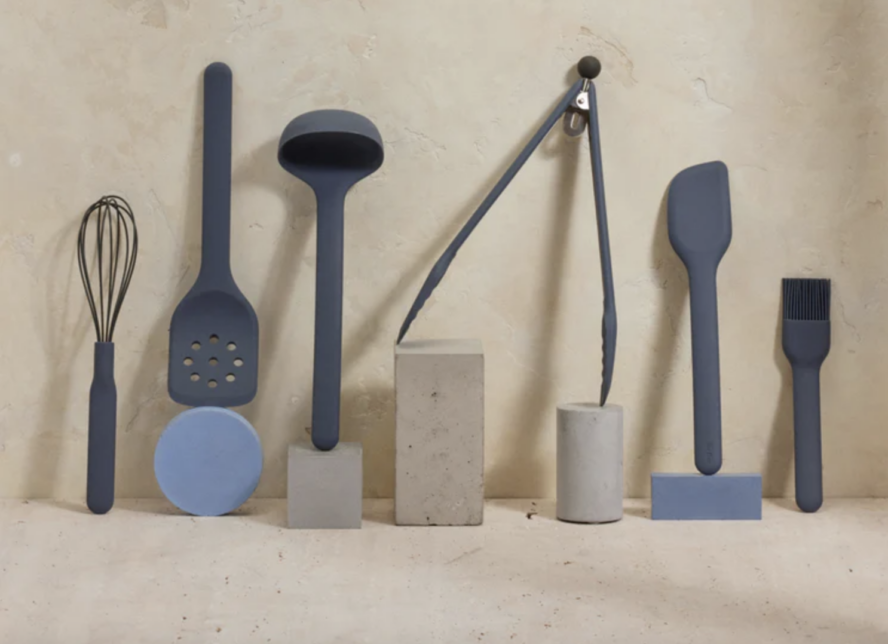
Metal utensils are a big no-no with traditional nonstick, and this is all the more true when it comes to delicate ceramic-coated pans. Even gentle scraping with metal tools can create micro scratches that reduce the nonstick performance.
Direct contact with metal utensils is even worse. Never cut food directly in these pans, and always flip with a silicone spatula rather than a metal one. Rounded utensil edges are especially great for reducing surface abrasion, so keep an eye out if you’re shopping for utensils. Many brands sell their own range of nonstick-safe tools to help preserve the lifespan of your pans.
Let It Cool Before Cleaning
Once you’re done cooking, it can be tempting to put your pan straight in the sink to keep food residue from sticking to it. But since ceramic pans are susceptible to thermal shock, you want to resist the urge to run your hot pan under cold water.
Instead, let the pan cool at room temperature for at least 5 to 10 minutes before washing, and for best results, use warm water — not hot or cold — and a soft sponge.
Store It Carefully — And Don’t Stack Without Protection

Stacking ceramic pans one on top of the other can chip the edges and scratch the surface. Luckily, many brands sell pan protectors that make it easy to safely store your pans. If you choose the right brand, your cookware set might even include pan organizers so that you don’t have to make an extra purchase.
However, if your cookware doesn’t come with an organizer and you don’t want to invest in even more tools, soft cloths will make a huge difference. Consider upcycling old clothing or dish towels — they make great pan protectors to extend the lifespan of your pans.
Is Ceramic Cookware Right for You?
Ceramic cookware is ideal for those who want a cleaner, lower-chemical option for cooking simple, healthy food, but isn’t a one-size-fits-all solution.
Best For: Light Daily Cooking and Health-Conscious Meals
If you mostly cook hearty, slow-simmering stews or high-heat seared steaks, ceramic cookware might not be the right choice for you. But if your meal roster includes delicate fish and silky scrambled eggs, or if you prefer sautéing veggies with little to no oil or butter, ceramic cookware might be the one for you.
Not Ideal For: High-Heat Cooking or Heavy Use
If you love a hard sear on your steaks and do a lot of open-flame, wok-style stir-fries, ceramic nonstick isn’t your best bet. It’s less durable than stainless steel or cast iron, and it’s not suitable for searing, broiling, high-heat stir-frying, or deep frying. If you frequently forget your pan on a hot flame or preheat aggressively, these are definitely not the pans for you.
Compare with Other Cookware Types
To get the most out of your ceramic-coated nonstick cookware, it’s best to see it as an ensemble cast member in your kitchen rather than the star. Think of your ceramic nonstick as the Joey Tribbiani of your pans — he’s a key player, but it’s FRIENDS, not the Joey Show. Durable cast iron and non-reactive stainless steel deserve a spot on your shelves, too, just like Joey needs cast members like Rachel and Phoebe to shine.
Reach for your cast iron for high-heat searing and recipes that require a move from the stovetop to the oven. Non-reactive stainless steel comes into play when you need to deglaze with wine to create delicious pan sauces. And your ceramic-coated nonstick is perfect for foods that require a more delicate touch.
If you’re in the market for more of a one-size-fits-all option, 100% ceramic ticks a lot of boxes. While the surface may not be as slippery as what you see with nonstick coated pans, it’s definitely up for the job — plus, pure ceramic cookware is a bit more robust, with the stovetop-to-oven capability of metal pans.
| Cooking Task | Ceramic Cookware Performance | Best Practices | Alternative Recommendation |
| Eggs (fried/scrambled) | Excellent when new; good with light use | Use low-medium heat; small amount of oil/butter | None needed; ideal application |
| Pancakes/Crepes | Excellent when new; good with light use | Preheat on low; use minimal fat | None needed; ideal application |
| Delicate Fish | Very good; prevents sticking and tearing | Medium-low heat; light oil coating | None needed; ideal application |
| Searing Meat | Fair; limited high-heat capability | Pre-heat slowly; avoid temperatures above 400°F | Cast iron or carbon steel |
| Acidic Foods and Sauces | Poor; accelerates coating degradation | Limit exposure time; avoid simmering | Stainless steel or enameled cast iron |
| Stir-Fry/High Heat | Poor; coating damage risk | Not recommended | Carbon steel wok or stainless steel |
| Oven Dishes | Varies by manufacturer (350-550°F max) | Check manufacturer temperature limits | Cast iron or stainless steel |
What to Look for When Buying Ceramic Cookware
When you’re looking for the perfect ceramic cookware for your kitchen, there are a few important characteristics to bear in mind.
Health Considerations Beyond PFAS-Free Claims
While ceramic cookware is often marketed as a healthier alternative to traditional nonstick, the reality is a bit more complex. Ceramic coatings are indeed free of PFAS — and since experts agree that PTFE nonstick isn’t safe, this is definitely a win. But the safety of these alternative coatings still depends on a host of other factors, including manufacturing standards, quality control, and usage patterns.
Other potential concerns may include nanoparticle migration, which a 2016 study in Food Additives & Contaminants found was a frequent concern3. This was particularly true for titanium dioxide, which, alongside aluminum oxide and zirconium oxide, is often found in ceramic coatings. Titanium dioxide has been linked to cell damage, genotoxicity, and inflammation, and it was classed as a possible human carcinogen by the International Agency for Research on Cancer4.
Health hazards of supposedly non-toxic nonstick vary widely depending on the brand you choose, given the range of manufacturing standards and quality control. Whenever possible, opt for higher-quality products from reputable brands, which undergo more rigorous testing for potential toxic contaminants like heavy metals.
Heavier Usually Means Higher Quality
If no other information is available when choosing your ceramic nonstick pans, try literally weighing your options. Go for a hefty pan — a heavier ceramic pan usually means it’s been made with better materials, and you’ll find it boasts a longer-lasting coating and more even heating. Premium pans typically feature a 3 to 5 mm base, which heats more consistently and resists warping.
Do a simple test in the store by picking up two pans of the same size. If a pan feels light and thin, it will likely wear out faster and will soon need to be replaced, while the heavier one is usually of better quality and made to last.
Look for Multiple Coating Layers
Just like with a manicure, multiple layers of ceramic coating will lend a more durable result. High-quality ceramic pans may have between three and five layers of coatings, while cheaper pans could have just one.
Single-layer coatings have a tendency to wear out within the year, whereas multi-layer pans last longer, with better protection from scratches, acids, and heat. When shopping, be sure to look for brands that are transparent about the number of coating layers they include.
Avoid Pans that Hide Their Materials
Speaking of transparency, a smart shopper will always look out for brands that are clear about where their pans are made, and with what materials. Look for details on the coating type (sol-gel or silicon dioxide is what you want), and check if the company lists the country where the pan was actually made — not just where it was designed.
Reliable brands will also offer honest use information, like the temperature limit and whether their pans are oven- or dishwasher-safe. Any brand that won’t tell you what coating they use, what metals are inside, or how to best care for your pan is a major red flag.
Certifications That Actually Matter
Rampant greenwashing has led to a host of labels, badges, and certifications that are relatively meaningless. When buying ceramic nonstick, keep an eye out for the certifications that actually mean something.
Perhaps the most important is an indication the pan has been tested for heavy metals and chemical safety. California Prop 65 limits lead and cadmium content significantly, due to their proven toxicity. And European food-contact standards are far more robust than similar standards in the U.S., so pans made in Europe or by European companies are often safer than American ones.
It’s also worth keeping an eye out for NSF International’s safety certifications. Above all, don’t trust buzzwords like “eco-friendly” or “green” unless the brand has the actual creds to back them up.
Final Thoughts: Making Informed Ceramic Cookware Decisions
Understanding the nuanced reality of ceramic cookware allows you to make choices that align with your cooking needs and health priorities. Ceramic cookware offers distinct health advantages over traditional nonstick, but it’s not a perfect solution for everyone. It’s essential to consider longevity, performance, health implications, and environmental impact, even when opting for this greener solution.
By taking a holistic approach to evaluating ceramic cookware, you’re extending conscious consumerism to your kitchen tools. Remember that no single cookware material is perfect for all your cooking needs — but a well-sourced non-toxic nonstick pan can be an essential player in your kitchen arsenal!
Sources:
- https://www.ewg.org/news-insights/news/why-are-dupont-and-chemours-still-discharging-most-notorious-forever-chemical
- https://www.wvtf.org/news/2023-01-25/what-do-researchers-know-about-the-health-impacts-of-genx
- https://www.tandfonline.com/doi/abs/10.1080/19440049.2016.1269954
- https://pmc.ncbi.nlm.nih.gov/articles/PMC3423755/

